
Lactase is an enzyme produced by many organisms and is essential to the complete digestion of whole milk. It breaks down the sugar lactose into its component parts, galactose and glucose. Lactase is found in the brush border of the small intestine of humans and other mammals. People deficient in lactase or lack functional lactase may experience the symptoms of lactose intolerance after consuming milk products. Lactase can be purchased as a food supplement and is added to milk to produce "lactose-free" milk products.

β-Galactosidase, is a glycoside hydrolase enzyme that catalyzes hydrolysis of terminal non-reducing β-D-galactose residues in β-D-galactosides.
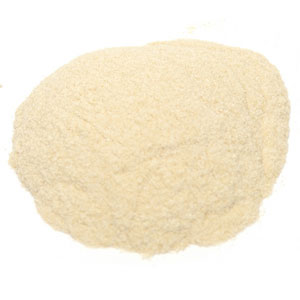
Pectin is a heteropolysaccharide, a structural acid contained in the primary lamella, in the middle lamella, and in the cell walls of terrestrial plants. The principal, chemical component of pectin is galacturonic acid which was isolated and described by Henri Braconnot in 1825. Commercially produced pectin is a white-to-light-brown powder, produced from citrus fruits for use as an edible gelling agent, especially in jams and jellies, dessert fillings, medications, and sweets; and as a food stabiliser in fruit juices and milk drinks, and as a source of dietary fiber.

Acetyl-CoA is a molecule that participates in many biochemical reactions in protein, carbohydrate and lipid metabolism. Its main function is to deliver the acetyl group to the citric acid cycle to be oxidized for energy production. Coenzyme A consists of a β-mercaptoethylamine group linked to the vitamin pantothenic acid (B5) through an amide linkage and 3'-phosphorylated ADP. The acetyl group of acetyl-CoA is linked to the sulfhydryl substituent of the β-mercaptoethylamine group. This thioester linkage is a "high energy" bond, which is particularly reactive. Hydrolysis of the thioester bond is exergonic (−31.5 kJ/mol).

Aspergillus niger is a mold classified within the Nigri section of the Aspergillus genus. The Aspergillus genus consists of common molds found throughout the environment within soil and water, on vegetation, in fecal matter, on decomposing matter, and suspended in the air. Species within this genus often grow quickly and can sporulate within a few days of germination. A combination of characteristics unique to A. niger makes the microbe invaluable to the production of many acids, proteins and bioactive compounds. Characteristics including extensive metabolic diversity, high production yield, secretion capability, and the ability to conduct post-translational modifications are responsible for A. niger's robust production of secondary metabolites. A. niger's capability to withstand extremely acidic conditions makes it especially important to the industrial production of citric acid.

An exoenzyme, or extracellular enzyme, is an enzyme that is secreted by a cell and functions outside that cell. Exoenzymes are produced by both prokaryotic and eukaryotic cells and have been shown to be a crucial component of many biological processes. Most often these enzymes are involved in the breakdown of larger macromolecules. The breakdown of these larger macromolecules is critical for allowing their constituents to pass through the cell membrane and enter into the cell. For humans and other complex organisms, this process is best characterized by the digestive system which breaks down solid food via exoenzymes. The small molecules, generated by the exoenzyme activity, enter into cells and are utilized for various cellular functions. Bacteria and fungi also produce exoenzymes to digest nutrients in their environment, and these organisms can be used to conduct laboratory assays to identify the presence and function of such exoenzymes. Some pathogenic species also use exoenzymes as virulence factors to assist in the spread of these disease-causing microorganisms. In addition to the integral roles in biological systems, different classes of microbial exoenzymes have been used by humans since pre-historic times for such diverse purposes as food production, biofuels, textile production and in the paper industry. Another important role that microbial exoenzymes serve is in the natural ecology and bioremediation of terrestrial and marine environments.

Pectic acid, also known as polygalacturonic acid, is a water-insoluble, transparent gelatinous acid existing in over-ripe fruit and some vegetables. It is a product of pectin degradation in plants, and is produced via the interaction between pectinase and pectin In the early stage of development of fruits, the pectic substance is a water-insoluble protopectin which is converted into pectin by the enzyme protopectinase during ripening of fruit. In over-ripe fruits, due to the presence of pectic methyl esterase enzyme, the pectin gets largely converted to pectic acid which is water-insoluble. Due to this reason both immature and over-ripe fruits are not suitable for making jelly and only ripe fruits are used.
Saprobionts are organisms that digest their food externally and then absorb the products. This process is called saprotrophic nutrition. Fungi are examples of saprobiontic organisms, which are a type of decomposer.
Pectinases are a group of enzymes that breaks down pectin, a polysaccharide found in plant cell walls, through hydrolysis, transelimination and deesterification reactions. Commonly referred to as pectic enzymes, they include pectolyase, pectozyme, and polygalacturonase, one of the most studied and widely used commercial pectinases. It is useful because pectin is the jelly-like matrix which helps cement plant cells together and in which other cell wall components, such as cellulose fibrils, are embedded. Therefore, pectinase enzymes are commonly used in processes involving the degradation of plant materials, such as speeding up the extraction of fruit juice from fruit, including apples and sapota. Pectinases have also been used in wine production since the 1960s. The function of pectinase in brewing is twofold, first it helps break down the plant material and so helps the extraction of flavors from the mash. Secondly the presence of pectin in finished wine causes a haze or slight cloudiness. Pectinase is used to break this down and so clear the wine.
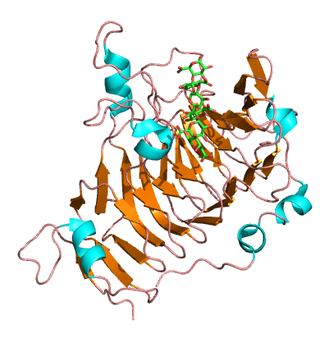
Pectinesterase (EC 3.1.1.11; systematic name pectin pectylhydrolase) is a ubiquitous cell-wall-associated enzyme that presents several isoforms that facilitate plant cell wall modification and subsequent breakdown. It catalyzes the following reaction:

α-Amylase is an enzyme that hydrolyses α bonds of large, α-linked polysaccharides, such as starch and glycogen, yielding shorter chains thereof, dextrins, and maltose:
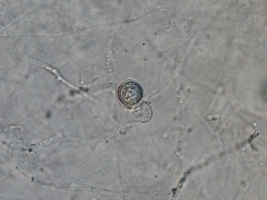
Pythium sulcatum is a chromalveolate plant pathogen infecting carrots. Because this organism was once thought to be a type of fungus, it is still often treated as such.
Pectate lyase is an enzyme involved in the maceration and soft rotting of plant tissue. Pectate lyase is responsible for the eliminative cleavage of pectate, yielding oligosaccharides with 4-deoxy-α-D-mann-4-enuronosyl groups at their non-reducing ends. The protein is maximally expressed late in pollen development. It has been suggested that the pollen expression of pectate lyase genes might relate to a requirement for pectin degradation during pollen tube growth.
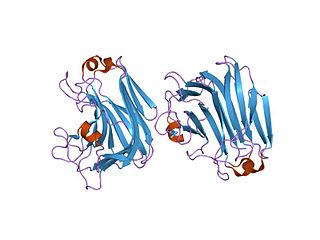
The enzyme mannuronate-specific alginate lyase catalyzes the degradation of alginate into various monosaccharide and polysaccharide products:

Rhamnogalacturonan-II (RG-II) is a complex polysaccharide component of pectin that is found in the primary cell walls of dicotyledonous and monocotyledonous plants and gymnosperms. It is supposed to be crucial for the plant cell wall integrity. RG-II is also likely to be present in the walls of some lower plants. Its global structure is conserved across vascular plants, albeit a number of variations within the RGII side chains have been observed between different plants. RG-II is composed of 12 different glycosyl residues including D-rhamnose, D-apiose, D-galactose, L-galactose, Kdo, D-galacturonic acid, L-arabinose, D-xylose, and L-aceric acid, linked together by at least 21 distinct glycosidic linkages. Some resides are further modified via methylation and acetylation. It moreover supports borate mediated cross-linking between different RGII side-chain apiosyl residues. The backbone consists of a linear polymer of alpha-1,4-linked D-galactopyranosiduronic acid. RG-II can be isolated from different sources, such as apple juice and red wine.

Endo-polygalacturonase (EC 3.2.1.15, pectin depolymerase, pectolase, pectin hydrolase, and poly-α-1,4-galacturonide glycanohydrolase; systematic name (1→4)-α-D-galacturonan glycanohydrolase (endo-cleaving)) is an enzyme that hydrolyzes the α-1,4 glycosidic bonds between galacturonic acid residues:
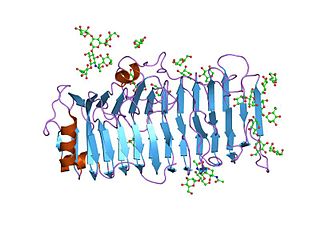
In molecular biology, glycoside hydrolase family 28 is a family of glycoside hydrolases EC 3.2.1., which are a widespread group of enzymes that hydrolyse the glycosidic bond between two or more carbohydrates, or between a carbohydrate and a non-carbohydrate moiety. A classification system for glycoside hydrolases, based on sequence similarity, has led to the definition of >100 different families. This classification is available on the CAZy web site, and also discussed at CAZypedia, an online encyclopedia of carbohydrate active enzymes.
Solid state fermentation (SSF) is a biomolecule manufacturing process used in the food, pharmaceutical, cosmetic, fuel and textile industries. These biomolecules are mostly metabolites generated by microorganisms grown on a solid support selected for this purpose. This technology for the culture of microorganisms is an alternative to liquid or submerged fermentation, used predominantly for industrial purposes.

Glucanases are enzymes that break down large polysaccharides via hydrolysis. The product of the hydrolysis reaction is called a glucan, a linear polysaccharide made of up to 1200 glucose monomers, held together with glycosidic bonds. Glucans are abundant in the endosperm cell walls of cereals such as barley, rye, sorghum, rice, and wheat. Glucanases are also referred to as lichenases, hydrolases, glycosidases, glycosyl hydrolases, and/or laminarinases. Many types of glucanases share similar amino acid sequences but vastly different substrates. Of the known endo-glucanases, 1,3-1,4-β-glucanase is considered the most active.
Ulvan lyase is an enzyme found within the cell-wall of the marine organism Ulvales, and some marine bacterium. A lyase is a class of enzyme that catalyzes the breakdown of chemical bonds through an elimination reaction mechanism, rather than a substitution reaction mechanism. Ulvan lyase belongs to the polysaccharide lyase family, a type of enzyme that primarily functions to cleave glycosidic linkages in polysaccharides.















